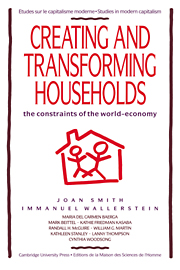Book contents
- Frontmatter
- Contents
- Preface
- I INTRODUCTION
- II THE UNITED STATES
- III MEXICO
- Introduction
- 1 Mexico City: the slow rise of wage-centered households
- 2 Central Mexico: the decline of subsistence and the rise of poverty
- IV SOUTHERN AFRICA
- V CONCLUSION
- A postscript on method
- References
- Index
- Studies in Modern Capitalism
2 - Central Mexico: the decline of subsistence and the rise of poverty
Published online by Cambridge University Press: 07 June 2010
- Frontmatter
- Contents
- Preface
- I INTRODUCTION
- II THE UNITED STATES
- III MEXICO
- Introduction
- 1 Mexico City: the slow rise of wage-centered households
- 2 Central Mexico: the decline of subsistence and the rise of poverty
- IV SOUTHERN AFRICA
- V CONCLUSION
- A postscript on method
- References
- Index
- Studies in Modern Capitalism
Summary
Throughout the nineteenth century the vast majority of the agricultural labor force employed by the estates of central Mexico consisted of temporary wage laborers, who worked only during the peak agricultural seasons, about six months out of the year. Most of these laborers were residents of small settlements (pueblos or ranchos), more or less independent of the large estates. The “debt peon,” who was permanently tied to a large hacienda, represented only a very small minority of the agricultural labor force. For the most part, laborers were recruited through wage advances made in cash or kind, but in general, payments were quite low. In addition, tenancy and sharecropping were frequent arrangements between the estates and temporary laborers. These laborers were dependent upon the estates, were often indebted, and were usually required to perform some wage labor in exchange for their access to the land. Furthermore, the more that the estates could extract surplus production, by means of rents and shares, the more peasants were obligated to work for wages. Throughout the 1880s and 1890s, the estates, responding to growing markets, sought to expand their landholdings and recruit more wage labor. Both of these ends were achieved precisely by expropriating village residents and smallholders of their lands. Many of these then became tenants and sharecroppers dependent upon the estates; others became wage laborers (Katz, 1974; Warman, 1976: 53–89).
The agricultural labor force was almost exclusively male, including boys who would accompany their fathers and earn one-half the adult wage.
- Type
- Chapter
- Information
- Creating and Transforming HouseholdsThe Constraints of the World-Economy, pp. 170 - 186Publisher: Cambridge University PressPrint publication year: 1992



